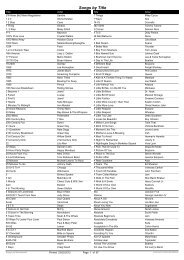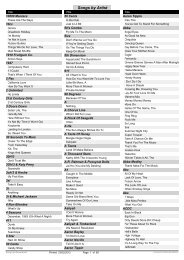Roderick W Rogers - members.westnet.com.au - Westnet
Roderick W Rogers - members.westnet.com.au - Westnet
Roderick W Rogers - members.westnet.com.au - Westnet
You also want an ePaper? Increase the reach of your titles
YUMPU automatically turns print PDFs into web optimized ePapers that Google loves.
Lichens of Subtropical Queensland R.W.<strong>Rogers</strong><br />
Tests are performed on either the upper surface (upper cortex) of the lichen, or on the<br />
medulla, a cottony layer beneath the cortex. The medulla is usually white, but is sometimes<br />
buff or even red.<br />
To carry out a test use a dropping rod or straightened paper clip to put a small drop of<br />
liquid on the cortex, and watch for colour changes. If you need to test the medulla, the<br />
most <strong>com</strong>mon test, then cut away a small area of cortex to expose the medulla, then place a<br />
drop of fluid (or gel if using beard colour for P tests) and watch for colour change. A<br />
colour change may take 20 seconds or so - and the colour may first be one colour (eg<br />
yellow) and then turn another (eg red). Sometimes the colour appears then vanishes after<br />
short time. Watch for changes!<br />
For a KC test first add a drop of K solution then a drop of C solution.<br />
Some lichen chemicals are fluorescent under ultra-violet light. UV reactions are rarely<br />
mentioned in these keys, but are taxonomically significant in a number of genera.<br />
The Colour of Lichens<br />
Lichens <strong>com</strong>monly have quite distinctive colours when they are air dry. All colour<br />
references in this account are for air-dry thalli.<br />
The <strong>com</strong>mon colours of lichens can be attributed to the accumulation of <strong>com</strong>plex organic<br />
chemicals in the upper and lower cortex. The colour of most lichens is therefore much the<br />
same whether living or dead. Some however, have no chemicals in their cortex or have<br />
radically different chemicals that may change with time after death of the lichen.<br />
Some <strong>com</strong>mon chemicals in the cortex of lichens and the resultant colours and tests:<br />
Lichen Ecology<br />
Thallus colour Chemical Test<br />
Grey Atranorin K+ yellow<br />
Grey Lichexanthone UV+ gold<br />
Yellow-green Usnic acid K-, KC+ yellow<br />
Gold Parietin K+ wine-red<br />
Olive-brown Melanins<br />
Lichens are very widespread organisms. They occur in the darkest rainforests and on rocks<br />
in full sun. Lichens grow on rainforest leaves, on tree trunks and twigs, on rocks in creeks<br />
and on the beach rock of Heron Island. Lichens are <strong>com</strong>mon on the soil on roadsides and<br />
inside eucalypt forests as well as on undisturbed soil in arid lands.<br />
Lichens have some peculiar sensitivities. By and large, lichens are sensitive to nutrient<br />
levels. City air is often too dirty for them, and lichens on tree trunks are killed by the<br />
12





